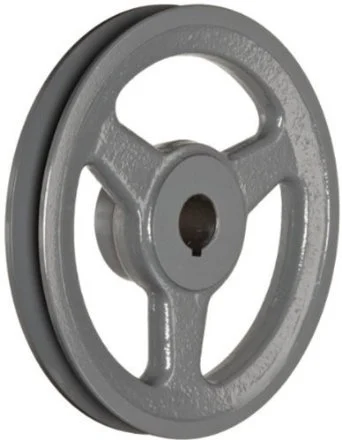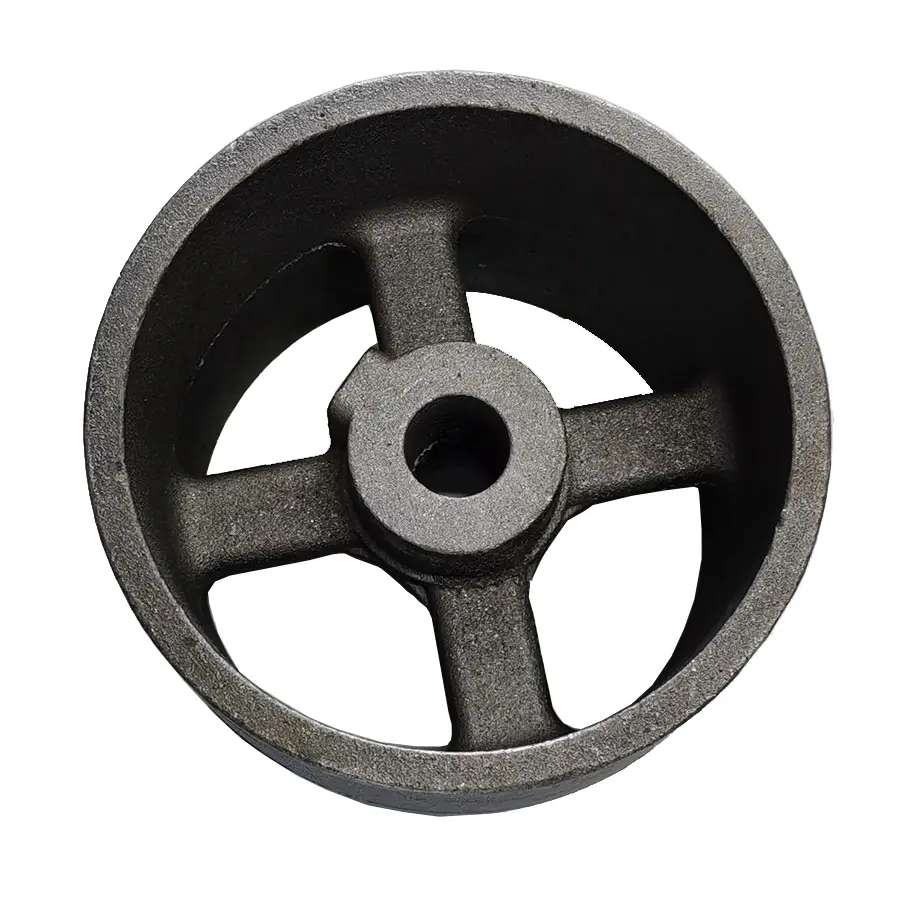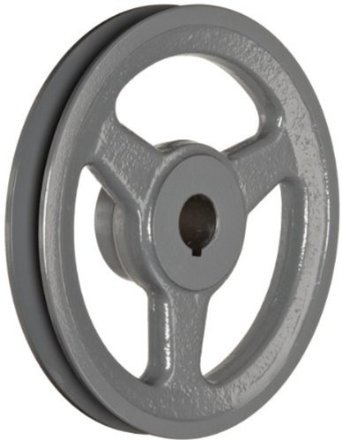Product Description
China Foundry Ductile Iron Motor Drive Pulley
Product Introduction
Material: Ductile iron, Stainless steel , Steel, Grey iron, Aluminium alloy, Copper alloy and so on.
Process: Sand Casting.
Heat Treatment: Quenching, Tempering, Annealing, Normalizing, Nitridation, Carburization.
Surface Treatment: Zinc-Plated, Hot dipping galvanized, Polishing, Painting, Powder coating.
Machining Equipment: CNC Machines, Turning Machines,Drilling Machines , Milling Machines, Grinding Machines,etc.
Measuring Tool: CMM, Projector, Vernier Caliper, Depth Caliper, Micrometer, Pin Gauge, Thread Gauge, Height Gauge, etc.
Weight: 0.1-3000kgs.
Application: Machinery Parts, Construction Industry, etc.
Package: Plywood or wooden case, pallet (As per customer’s requirement).
Manufacturing process
1. Sample or Drawing by customer
2. Tooling proposal&Discussion
3.3D Tooling Design
4. Tooling production
5. Rough parts manufacturer
6. CNC Machining
7. Fitting&Finish
8. Tooling Measurement&Check
9. Assembly
10. Trial Production
11. Correction
12. Final Trial
13. Samples Inspection
14. Sample Approval by customer
15. Tooling Approval
16. ISO9001 high quality brass forging
Our Inspection Equipment:
Direct-reading spectrograph,metallographic microscope,hardness tester,brinell hardness tester,thermometric indicator,universal testing machine,carbon and silicon analysis meter,magnetic powder flaw detector,digital ultrasonic flaw detector etc.
Our Service:
1.Your inquiry related to our products or prices will be replied in 12 hours.
2.Individual formula according to customers’ special drawing requests.
3.Manufacturer with large capacity,ensures the fast production cycle after
confirming the order.
4.Protection of sales area and private information for all of our customers.
Quality Control:
We have a full set of quality control system to guarantee best product quality. Depending on the products, we can make different Item Testing Plan, Manufacturing procedure etc.
Raw material control
Chemistry spectrum analysis
Mechanical property
Metallographic analysis
Ultrasonic testing
Magnetic testing
Radiographic testing
Dimension inspection
Visual inspection
Penetrant testing
Leak testing
Hardness test
Micro-structure tester after heat treatment
Machining Ability
Our machining shop located in HangZhou using the latest CNC equipment to provide our customer with high quality products.
Horizontal and Vertical Machining Center
CNC lathe and normal lathe
CNC drilling and milling Center
Other assistant equipment
Product Design and casting simulation
Successful parts are original from successful design. We own high level engineers on the product design. They are good at make drawing using the software of CAD. PROE, SOLIDWORKS for assuring production process well.
Our technical group have rich experience in casting process, so we can put CHINAMFG reasonable suggestions to the product structure design on various performance, process parameters to solve the customer’s requirement, set up the 3D model, get the results from pouring simulation analysis. Then modify and optimize the scheme to determine the correct casting
HangZhou CHINAMFG Machinery Co., Ltd is 1 famous company in China which specialized in various metal casting products with over 10 years experience located in HangZhou China. It covers a comprehensive range of forging, stamping, sand casting, investment casting, die casting and machining and was widely used in Agriculture machinery, Motor Vehicle, Architecture, Railway and Engineering
As a professional company, CHINAMFG have 4 groups of experienced teams to be in charge of different work:
Project team-customer service
Engineering team-provide R&D and technical support
QC team-productive process control and incoming parts inspection
Warehouse team-warehouse management and logistic service
| material | grey cast iron, ductile cast iron, steel, stainless steel, brass, copper, bronze, aluminum, zinc etc |
| process | sand casting, precision casting ,die casting |
| Surface finishment | polishing, sand blasting, heat treatment, painting, powder coating, anodizing, electroplating, mirror polishing. |
| certificate | ISO9001 |
| Service | OEM service available |
| Main export market | Eastern Europe Western Europe North America Mid Africa Central America Asia Australia |
/* January 22, 2571 19:08:37 */!function(){function s(e,r){var a,o={};try{e&&e.split(“,”).forEach(function(e,t){e&&(a=e.match(/(.*?):(.*)$/))&&1
| Certification: | CE |
|---|---|
| Pulley Sizes: | Type A |
| Manufacturing Process: | Casting |
| Material: | Iron |
| Surface Treatment: | Polishing |
| Application: | Chemical Industry, Grain Transport, Mining Transport, Power Plant |
| Customization: |
Available
| Customized Request |
|---|

How are cast iron pulleys integrated into conveyor systems for material handling?
Cast iron pulleys play a crucial role in conveyor systems for material handling, enabling the efficient movement of goods and materials. Their integration involves various components and considerations to ensure smooth operation and optimal performance. Here’s a detailed explanation of how cast iron pulleys are integrated into conveyor systems for material handling:
- Pulley Types: Conveyor systems utilize different types of cast iron pulleys depending on the specific requirements of the application. Common types include drive pulleys, which transfer power from the motor to the conveyor belt, and idler pulleys, which support and guide the belt. Drive pulleys typically have a larger diameter and are connected to the motor shaft, while idler pulleys are used to maintain belt tension and alignment. The selection of the appropriate pulley types depends on factors such as load capacity, belt speed, and the overall conveyor design.
- Pulley Placement: The placement of cast iron pulleys within the conveyor system is critical for proper belt tracking and tensioning. Drive pulleys are typically located at the head of the conveyor, where they receive power from the motor and initiate belt movement. Idler pulleys are strategically positioned along the conveyor path to support the belt and maintain its alignment. The number and arrangement of idler pulleys depend on factors such as belt length, load distribution, and the desired belt trajectory.
- Belt Engagement: Cast iron pulleys are designed with grooves or channels that engage with the conveyor belt. The pulley’s groove profile corresponds to the shape and dimensions of the belt, ensuring proper alignment and grip. The belt wraps around the pulley’s circumference, and the friction between the belt and the pulley surface enables power transmission and movement. The design of the pulley’s groove profile and surface finish is crucial for minimizing belt slippage, optimizing power transfer, and reducing wear on the belt and pulley.
- Bearing Arrangement: Cast iron pulleys are equipped with bearings to facilitate smooth rotation and reduce friction. The bearings are typically mounted within the pulley’s hub or housing, allowing the pulley to rotate freely on its shaft. Proper bearing selection, placement, and lubrication are essential to ensure reliable and efficient operation. Sealed or shielded bearings may be used to protect against environmental contaminants and extend the bearing’s service life. The pulley’s bearing arrangement should be designed to handle the anticipated loads and provide adequate support for the pulley’s rotational motion.
- Tensioning and Tracking: Cast iron pulleys play a role in maintaining proper belt tension and tracking. Tensioning mechanisms, such as take-up systems, are often incorporated into the conveyor system to adjust the belt’s tension and compensate for stretching or wear over time. Idler pulleys, positioned strategically along the conveyor path, help maintain the belt’s alignment and prevent tracking issues. Proper tensioning and tracking mechanisms, combined with well-designed pulleys, ensure optimal belt performance, minimize belt wear, and prevent belt misalignment or damage.
- System Integration: Integrating cast iron pulleys into a conveyor system involves considering the overall design and coordination with other components. This includes aligning the pulley sizes, belt specifications, and drive system requirements. The pulleys should be properly sized to accommodate the anticipated loads and belt speed. Additionally, the pulley’s shaft diameter and keyway design should align with the motor or drive system’s specifications to ensure proper connection and power transmission. Proper integration ensures the smooth operation and efficiency of the conveyor system for material handling.
In summary, cast iron pulleys are integrated into conveyor systems for material handling through careful consideration of pulley types, placement, belt engagement, bearing arrangement, tensioning and tracking mechanisms, and overall system integration. By selecting the appropriate pulley types, positioning them correctly, ensuring proper belt engagement and tensioning, and coordinating with other system components, engineers can design conveyor systems that efficiently transport materials, minimize belt wear, and ensure reliable performance in various material handling applications.

Can cast iron pulleys withstand harsh environmental conditions?
Cast iron pulleys are known for their durability and ability to withstand various environmental conditions. However, their performance in harsh environments depends on several factors, including the specific type of cast iron used, the severity and duration of the environmental conditions, and the presence of protective measures. Here’s a detailed explanation of cast iron pulleys’ ability to withstand harsh environmental conditions:
- Material Composition: Cast iron pulleys are typically made from materials such as gray cast iron, ductile cast iron, or alloyed cast iron. These materials offer good resistance to corrosion, heat, and wear. Gray cast iron, for example, has excellent dampening properties and is resistant to thermal expansion, making it suitable for many industrial applications. Ductile cast iron provides higher tensile strength and toughness, making it more resistant to impact and shock. Alloyed cast iron may offer enhanced resistance to specific environmental factors. The specific material composition of the pulley can influence its ability to withstand harsh conditions.
- Corrosion Resistance: Cast iron pulleys have inherent resistance to corrosion due to the formation of a protective oxide layer on their surface. However, in extremely corrosive environments, additional protective measures may be necessary. This can include applying surface treatments such as coatings or paints that provide enhanced resistance to specific corrosive agents or environments. Regular maintenance and inspection can help identify and address any signs of corrosion, ensuring the longevity of the pulleys.
- Temperature Extremes: Cast iron pulleys generally have good heat resistance, allowing them to withstand high temperatures without significant deformation or material degradation. However, in extremely high-temperature environments, the pulley’s performance may be affected. Factors such as thermal expansion, heat dissipation, and the presence of cooling mechanisms should be considered in the design and operation of cast iron pulleys in high-temperature conditions. Similarly, in extremely low-temperature environments, the pulley’s brittleness may increase, potentially impacting its performance.
- Humidity and Moisture: Cast iron pulleys are generally resistant to the effects of humidity and moisture. However, prolonged exposure to high humidity or immersion in water can lead to rust formation. Proper sealing, protective coatings, or the use of stainless steel components in critical areas can enhance the pulley’s resistance to moisture-related issues. Regular inspection and maintenance can help identify and address any moisture-related concerns.
- Chemical Exposure: Cast iron pulleys can withstand exposure to many chemicals commonly encountered in industrial environments. However, exposure to highly corrosive chemicals or aggressive solvents can affect the pulley’s performance. In such cases, chemical-resistant coatings or alternative materials may need to be considered. Understanding the specific chemical environment and consulting with experts can help determine the best approach to ensure the pulley’s compatibility with harsh chemical conditions.
- Protective Measures: In particularly harsh environmental conditions, additional protective measures can be employed to enhance the pulley’s resistance. This can include the use of protective covers, seals, or enclosures to shield the pulley from direct exposure to environmental factors. Sealing arrangements can prevent the ingress of dust, debris, or moisture into the pulley’s internal components, reducing the risk of damage or performance degradation.
In summary, cast iron pulleys generally possess good resistance to harsh environmental conditions. Their durability, corrosion resistance, and heat resistance make them suitable for a wide range of applications. However, the pulley’s ability to withstand specific harsh conditions depends on factors such as material composition, corrosion resistance, temperature extremes, humidity and moisture, chemical exposure, and the implementation of protective measures. By considering these factors and implementing appropriate measures, cast iron pulleys can be effectively used in harsh environments, ensuring their long-term performance and reliability.

What advantages do cast iron pulleys offer for power transmission?
Cast iron pulleys offer several advantages when it comes to power transmission in machinery and mechanical systems. Their unique characteristics and properties make them a preferred choice in numerous applications. Here’s a detailed explanation of the advantages that cast iron pulleys offer for power transmission:
- Strength and Durability: Cast iron pulleys are known for their exceptional strength and durability. The material composition of cast iron provides high tensile strength and resistance to wear and tear. This allows cast iron pulleys to withstand heavy loads and continuous operation, making them suitable for power transmission applications in demanding environments.
- Heat Resistance: Cast iron pulleys exhibit excellent heat resistance, allowing them to operate in high-temperature conditions without deformation or loss of performance. This property is particularly beneficial in applications where power transmission involves elevated temperatures, such as in engines, industrial machinery, and manufacturing processes. Cast iron pulleys can effectively transmit power without compromising their structural integrity under extreme heat.
- Stability and Vibration Dampening: Cast iron pulleys offer inherent stability and vibration dampening properties. The dense and rigid nature of cast iron helps reduce vibrations generated during power transmission, leading to smoother and more efficient operation of machinery. This stability is especially advantageous in precision applications, such as woodworking machinery or equipment where precise cuts, movements, or measurements are required.
- Compatibility with Various Belt Types: Cast iron pulleys are designed to be compatible with different types of belts, such as V-belts, flat belts, timing belts, and round belts. This versatility allows for flexibility in power transmission systems, enabling the use of the most suitable belt type for specific applications. Cast iron pulleys provide reliable grip and traction, ensuring efficient power transfer between the pulley and the belt.
- Wide Range of Sizes and Configurations: Cast iron pulleys are available in a wide range of sizes, configurations, and designs to accommodate diverse power transmission requirements. This adaptability allows for customization and optimization of power transmission systems in various machinery and mechanical setups. Whether it’s a small pulley for precise movements or a large pulley for heavy-duty applications, cast iron pulleys can be tailored to specific needs.
- Cost-Effectiveness: Cast iron pulleys offer a cost-effective solution for power transmission. The manufacturing process of cast iron pulleys is efficient and economical, making them relatively affordable compared to other materials or pulley types. Additionally, the durability and longevity of cast iron pulleys contribute to reduced maintenance and replacement costs over the long term.
In summary, cast iron pulleys provide several advantages for power transmission, including strength and durability, heat resistance, stability and vibration dampening, compatibility with various belt types, a wide range of sizes and configurations, and cost-effectiveness. These advantages make cast iron pulleys a reliable and efficient choice for transmitting power in machinery and mechanical systems across various industries.


editor by CX
2024-05-08